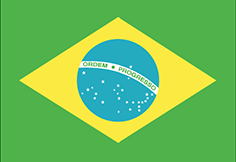Rio de Janeiro with its iconic landscape is perhaps one of the most famous beach and party towns on the planet. Rio's beaches are beautiful and a great place to experience Brazilian beach culture and perhaps even play a little volleyball. Head to the Copacabana or Ipanema beach to chill at two of the most famous beaches in the world. The famous Cristo Redentor (Christ the Redeemer) statue is located on top of the Corcovado. From this mountain you have an absolutely spectacular view of the city and its unique setting. In fact, the entire area of Rio with its stunning mountain and beach scenery is one UNESCO World Heritage Site. Rio does have a bit of a crime problem, so before coming here make sure you have your Brazil travel insurance sorted!
If you come in February during the Carnival, you get to see the party side of Rio and what a party it is. The whole city turns out for 3 days of craziness. If you are in Rio this time of year, you will enjoy the party of a lifetime, though you may also find your memory of events a bit hazy after many Caipirinhas!
South of Rio is the city of São Paulo, which has a population of roughly 11 million people making it Brazil's largest city. Getting around can be a bit difficult, due to the sheer size of the city. However, the excellent restaurants, distinctive neighborhoods, and selection of museums make São Paulo well worth exploring. If you find yourself here, make sure to explore Avenida Paulistas and go up the highest building to enjoy a breathtaking view of downtown and experience the sheer size of the city stretching out in all directions towards the horizon.
In the Central West region of Brazil you will find the Distrito Federal. This region is home to the country's capital, Brasília. Brasília stands testament to the visions of town planner Lucio Costa and architect Oscar Niemayer, who designed this entire city from scratch. The clean lines and overall harmony of the design is impressive not just to architecture buffs.
The northeast of Brazil has some of the hottest climate in the country, and boasts a unique mix of black culture mixed with Iberic and indigenous traditions. The food here is heavily reminiscent of African and Indian traditions, with palm oil and coconuts forming favorite staples. In this area you will also find the famous Brazilian Atlantic Islands Fernando de Noronha and Atol das Rocas, which are important breeding grounds for sharks, tuna and turtles. While in this region, make sure to visit the historic center of Brazil's first capital, Salvador de Bahia.
Towards the northwest of Brazil you will find the Amazon conservation area, and if you want to enter a wild rainforest, this is definitely the place. This is the most unexplored area of the country, as the cities themselves leave much to be desired in terms of tourism. The region is however notable for its protection of the Amazon forest and there are several Amazon River cruises operating out of Manaus.
The south of Brazil borders on Uruguay, Argentina and Paraguay, is one of the most economically developed in the country, and has some of the top travel destinations. In fact, a lot of Brazilians and Argentinian's tend to enjoy their vacations in this beautiful area. The beach town of Florianópolis has some of Brazil's most beautiful beaches and is a perfect destination to relax for a couple of days. With most European immigrants being in this area, you can also find an active German community around Blumenau, and there is even a version of the famous Oktoberfest celebrated here. The south also offers access to Iguaçu Falls, which are shared between Argentina and Brazil.
While Brazil is beautiful and the people generally friendly, it is important to note that crime is a bit of a problem when travelling around. In bigger cities it is important not to flash expensive jewelry or equipment, and unless you are on an organized tour, do stay away from the favelas. As a precaution, ensure you have travel insurance for Brazil before you depart.
For anyone wanting to explore new cuisines, Brazil is a dream come true: each region has its regional specialties, and with a high immigrant population, you can find many popular European menu items as well. Being home to the largest Japanese community outside of Japan means that you can also get authentic Japanese sushi here. One word of warning: Brazilian cooking is very heavy, which is a bit unexpected with such a hot climate and eating can result in gentle sweating. Having said that, do make sure to try feijoada (a hearty pork and bean stew) and a good mocequa (a delicious seafood and coconut milk stew) while you’re at the coast.
 †
†



